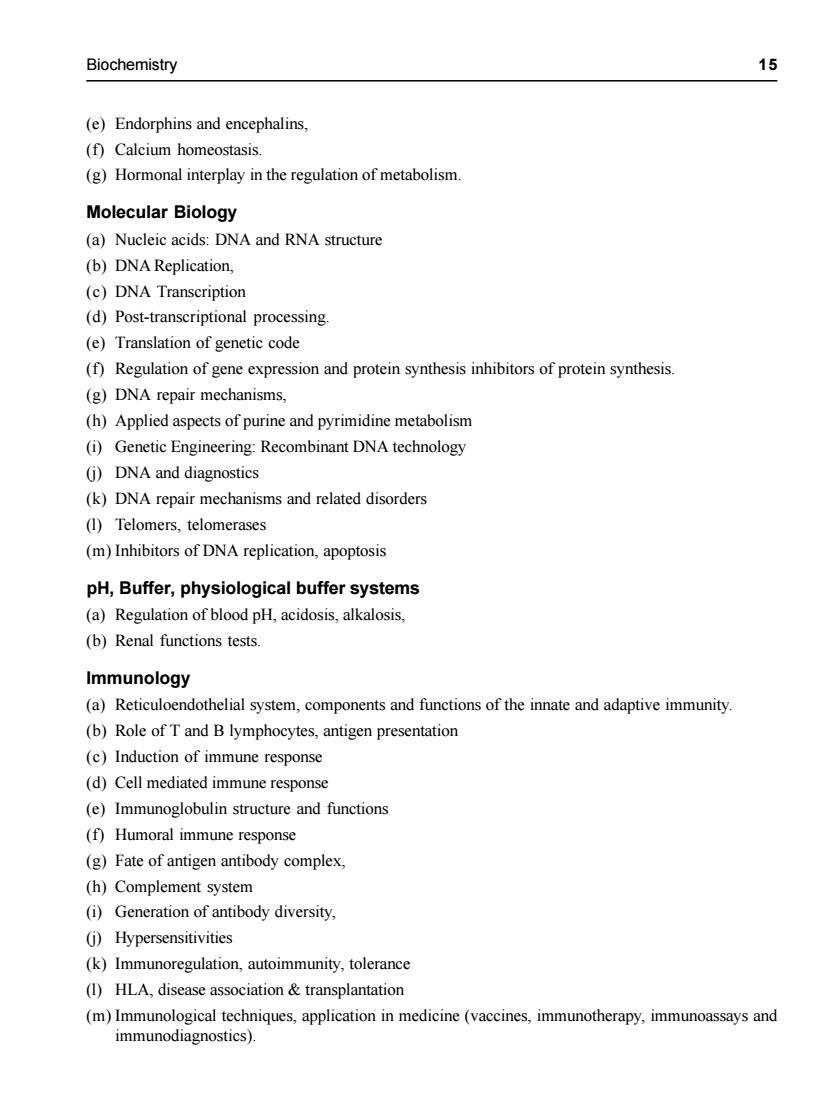
15Biochemistry(e)Endorphins and encephalins,(f) Calcium homeostasis.(g)Hormonal interplayintheregulationofmetabolismMolecular Biology(a)Nucleic acids:DNAandRNA structure(b)DNAReplication(c)DNA Transcription(d) Post-transcriptional processing.(e) Translation of genetic code(f)Regulation of gene expression and protein synthesis inhibitors of protein synthesis(g)DNArepairmechanisms(h)Appliedaspectsofpurineandpyrimidinemetabolism(i)GeneticEngineering:RecombinantDNAtechnology()DNA and diagnostics(k) DNA repair mechanisms and related disorders(l)Telomers, telomerases(m)Inhibitors of DNA replication, apoptosispH,Buffer,physiologicalbuffersystems(a)Regulationofblood pH,acidosis, alkalosis,(b)Renal functions testsImmunology(a)Reticuloendothelialsystem,components andfunctions oftheinnateandadaptiveimmunity.(b) Role of T and B lymphocytes, antigen presentation(c) Induction of immune response(d) Cell mediated immune response(e)Immunoglobulin structure and functions(f)Humoral immune response(g)Fateof antigenantibodycomplex(h)Complement system(i)Generationofantibodydiversity,)Hypersensitivities(k)Immunoregulation,autoimmunity,tolerance(l)HLA,disease association&transplantation(m)Immunologicaltechniques,application in medicine (vaccines,immunotherapy,immunoassaysandimmunodiagnostics)
Biochemistry 15 (e) Endorphins and encephalins, (f) Calcium homeostasis. (g) Hormonal interplay in the regulation of metabolism. Molecular Biology (a) Nucleic acids: DNA and RNA structure (b) DNA Replication, (c) DNA Transcription (d) Post-transcriptional processing. (e) Translation of genetic code (f) Regulation of gene expression and protein synthesis inhibitors of protein synthesis. (g) DNA repair mechanisms, (h) Applied aspects of purine and pyrimidine metabolism (i) Genetic Engineering: Recombinant DNA technology (j) DNA and diagnostics (k) DNA repair mechanisms and related disorders (l) Telomers, telomerases (m) Inhibitors of DNA replication, apoptosis pH, Buffer, physiological buffer systems (a) Regulation of blood pH, acidosis, alkalosis, (b) Renal functions tests. Immunology (a) Reticuloendothelial system, components and functions of the innate and adaptive immunity. (b) Role of T and B lymphocytes, antigen presentation (c) Induction of immune response (d) Cell mediated immune response (e) Immunoglobulin structure and functions (f) Humoral immune response (g) Fate of antigen antibody complex, (h) Complement system (i) Generation of antibody diversity, (j) Hypersensitivities (k) Immunoregulation, autoimmunity, tolerance (l) HLA, disease association & transplantation (m) Immunological techniques, application in medicine (vaccines, immunotherapy, immunoassays and immunodiagnostics)
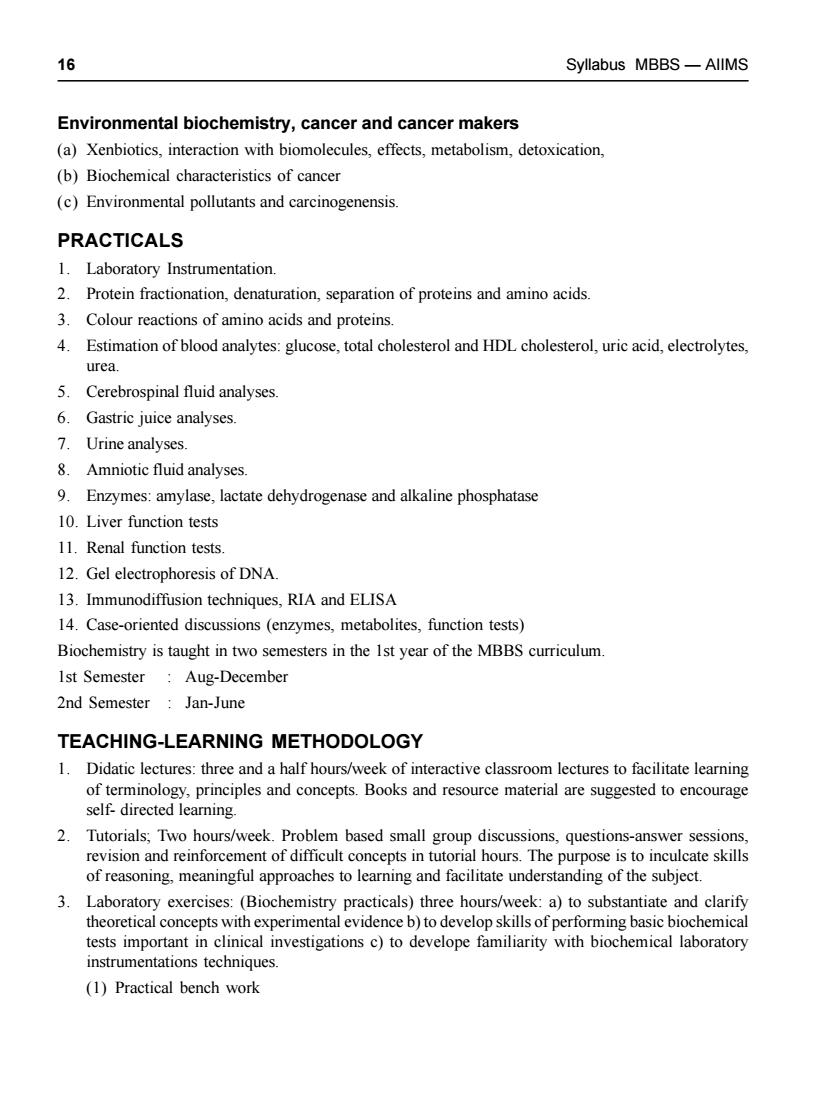
16Syllabus MBBS—AIIMSEnvironmentalbiochemistry,cancerandcancermakers(a)Xenbiotics,interactionwithbiomolecules,effects,metabolism,detoxication,(b)Biochemical characteristicsofcancer(c)Environmental pollutants and carcinogenensis.PRACTICALS1.LaboratoryInstrumentation2. Protein fractionation, denaturation, separation of proteins and amino acids.3.Colourreactions ofaminoacids andproteins.4.Estimation of blood analytes: glucose, total cholesterol and HDL cholesterol, uric acid, electrolytes,urea.5.Cerebrospinal fluid analyses6.Gastric juice analyses7.Urine analyses.8.Amnioticfluidanalyses.9.Enzymes: amylase, lactate dehydrogenase and alkaline phosphatase10. Liver function tests11.Renal function tests.12.GelelectrophoresisofDNA.13.Immunodiffusion techniques, RIA and ELISA14.Case-oriented discussions (enzymes,metabolites,functiontests)Biochemistry is taught in two semesters in the 1st year of the MBBS curriculumIst SemesterAug-December2ndSemester:Jan-JuneTEACHING-LEARNINGMETHODOLOGY1.Didatic lectures: three and a half hours/week of interactive classroom lectures to facilitate learningofterminology,principlesandconcepts.Booksandresourcematerialaresuggestedtoencourageself- directed learning.2.Tutorials;Two hours/week.Problem based small groupdiscussions,questions-answer sessionsrevision and reinforcement of difficult concepts in tutorial hours.The purpose is to inculcate skillsof reasoning,meaningful approaches to learning and facilitate understanding of the subject.3.Laboratoryexercises:(Biochemistrypracticals)threehours/week:a)to substantiateandclarifytheoreticalconceptswithexperimentalevidenceb)todevelopskillsofperformingbasicbiochemicaltests important in clinical investigations c)to develope familiarity with biochemical laboratoryinstrumentations techniques.(1) Practical bench work
16 Syllabus MBBS — AIIMS Environmental biochemistry, cancer and cancer makers (a) Xenbiotics, interaction with biomolecules, effects, metabolism, detoxication, (b) Biochemical characteristics of cancer (c) Environmental pollutants and carcinogenensis. PRACTICALS 1. Laboratory Instrumentation. 2. Protein fractionation, denaturation, separation of proteins and amino acids. 3. Colour reactions of amino acids and proteins. 4. Estimation of blood analytes: glucose, total cholesterol and HDL cholesterol, uric acid, electrolytes, urea. 5. Cerebrospinal fluid analyses. 6. Gastric juice analyses. 7. Urine analyses. 8. Amniotic fluid analyses. 9. Enzymes: amylase, lactate dehydrogenase and alkaline phosphatase 10. Liver function tests 11. Renal function tests. 12. Gel electrophoresis of DNA. 13. Immunodiffusion techniques, RIA and ELISA 14. Case-oriented discussions (enzymes, metabolites, function tests) Biochemistry is taught in two semesters in the 1st year of the MBBS curriculum. 1st Semester : Aug-December 2nd Semester : Jan-June TEACHING-LEARNING METHODOLOGY 1. Didatic lectures: three and a half hours/week of interactive classroom lectures to facilitate learning of terminology, principles and concepts. Books and resource material are suggested to encourage self- directed learning. 2. Tutorials; Two hours/week. Problem based small group discussions, questions-answer sessions, revision and reinforcement of difficult concepts in tutorial hours. The purpose is to inculcate skills of reasoning, meaningful approaches to learning and facilitate understanding of the subject. 3. Laboratory exercises: (Biochemistry practicals) three hours/week: a) to substantiate and clarify theoretical concepts with experimental evidence b) to develop skills of performing basic biochemical tests important in clinical investigations c) to develope familiarity with biochemical laboratory instrumentations techniques. (1) Practical bench work
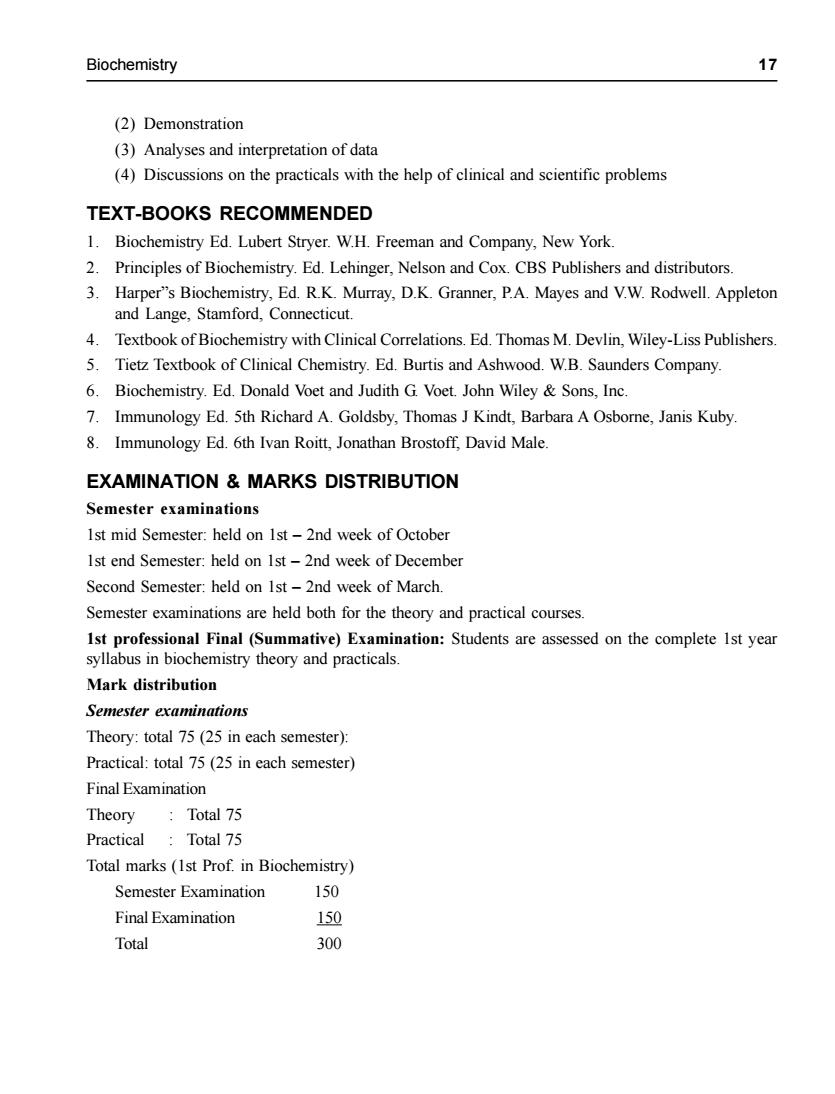
17Biochemistry(2)Demonstration(3)Analysesand interpretationofdata(4)Discussionsonthepracticals withthehelpof clinical and scientificproblemsTEXT-BOOKSRECOMMENDED1.Biochemistry Ed. Lubert Stryer.W.H. Freeman and Company, New York.2.Principles of Biochemistry.Ed.Lehinger,Nelson and Cox.CBS Publishers and distributors3.Harper"s Biochemistry,Ed. R.K. Murray,D.K. Granner, P.A.Mayes and V.W.Rodwell. Appletonand Lange, Stamford, Connecticut.4.Textbook ofBiochemistrywith Clinical Correlations.Ed.Thomas M.Devlin, Wiley-Liss Publishers.5.TietzTextbook of Clinical Chemistry.Ed.Burtis andAshwood.W.B.Saunders Company.6.Biochemistry.Ed.Donald Voet and Judith G Voet. John Wiley & Sons, Inc.7.ImmunologyEd.5thRichardA.Goldsby,ThomasJKindt,BarbaraAOsborne,JanisKuby8.ImmunologyEd.6thIvanRoitt,JonathanBrostoff,DavidMaleEXAMINATION&MARKSDISTRIBUTIONSemesterexaminationsIstmidSemester:held onIst-2ndweekof OctoberIstendSemester:heldon1st-2ndweekofDecemberSecond Semester: held on 1st -2nd week of March.Semester examinations areheld bothforthetheoryand practical courses1st professional Final (Summative) Examination: Students are assessed on the complete lst yearsyllabus in biochemistry theory and practicalsMark distributionSemesterexaminationsTheory: total 75 (25 in each semester):Practical: total 75 (25 in each semester)Final ExaminationTheory:Total 75Practical:Total75Total marks (1st Prof. in Biochemistry)150SemesterExamination150Final ExaminationTotal300
Biochemistry 17 (2) Demonstration (3) Analyses and interpretation of data (4) Discussions on the practicals with the help of clinical and scientific problems TEXT-BOOKS RECOMMENDED 1. Biochemistry Ed. Lubert Stryer. W.H. Freeman and Company, New York. 2. Principles of Biochemistry. Ed. Lehinger, Nelson and Cox. CBS Publishers and distributors. 3. Harper”s Biochemistry, Ed. R.K. Murray, D.K. Granner, P.A. Mayes and V.W. Rodwell. Appleton and Lange, Stamford, Connecticut. 4. Textbook of Biochemistry with Clinical Correlations. Ed. Thomas M. Devlin, Wiley-Liss Publishers. 5. Tietz Textbook of Clinical Chemistry. Ed. Burtis and Ashwood. W.B. Saunders Company. 6. Biochemistry. Ed. Donald Voet and Judith G. Voet. John Wiley & Sons, Inc. 7. Immunology Ed. 5th Richard A. Goldsby, Thomas J Kindt, Barbara A Osborne, Janis Kuby. 8. Immunology Ed. 6th Ivan Roitt, Jonathan Brostoff, David Male. EXAMINATION & MARKS DISTRIBUTION Semester examinations 1st mid Semester: held on 1st – 2nd week of October 1st end Semester: held on 1st – 2nd week of December Second Semester: held on 1st – 2nd week of March. Semester examinations are held both for the theory and practical courses. 1st professional Final (Summative) Examination: Students are assessed on the complete 1st year syllabus in biochemistry theory and practicals. Mark distribution Semester examinations Theory: total 75 (25 in each semester): Practical: total 75 (25 in each semester) Final Examination Theory : Total 75 Practical : Total 75 Total marks (1st Prof. in Biochemistry) Semester Examination 150 Final Examination 150 Total 300
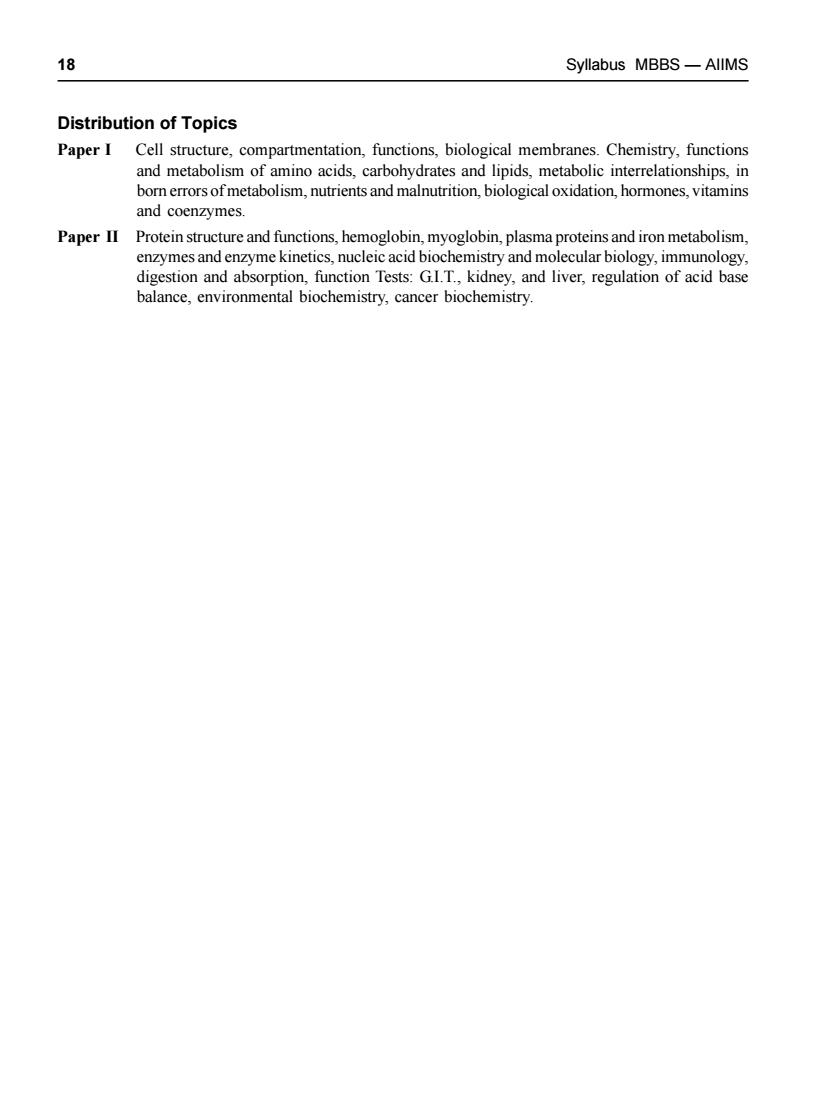
18Syllabus MBBS-AlIMSDistributionofTopicsPaper ICell structure, compartmentation, functions, biological membranes. Chemistry, functionsand metabolism of amino acids, carbohydrates and lipids, metabolic interrelationships, inbornerrorsofmetabolism,nutrientsandmalnutrition,biologicaloxidation,hormones,vitaminsand coenzymes.Paper IIProtein structure and functions, hemoglobin, myoglobin, plasma proteins and iron metabolismenzymes and enzyme kinetics, nucleic acid biochemistry and molecular biology, immunology,digestion and absorption, function Tests: GI.T, kidney, and liver, regulation of acid basebalance,environmentalbiochemistry,cancerbiochemistry
18 Syllabus MBBS — AIIMS Distribution of Topics Paper I Cell structure, compartmentation, functions, biological membranes. Chemistry, functions and metabolism of amino acids, carbohydrates and lipids, metabolic interrelationships, in born errors of metabolism, nutrients and malnutrition, biological oxidation, hormones, vitamins and coenzymes. Paper II Protein structure and functions, hemoglobin, myoglobin, plasma proteins and iron metabolism, enzymes and enzyme kinetics, nucleic acid biochemistry and molecular biology, immunology, digestion and absorption, function Tests: G.I.T., kidney, and liver, regulation of acid base balance, environmental biochemistry, cancer biochemistry
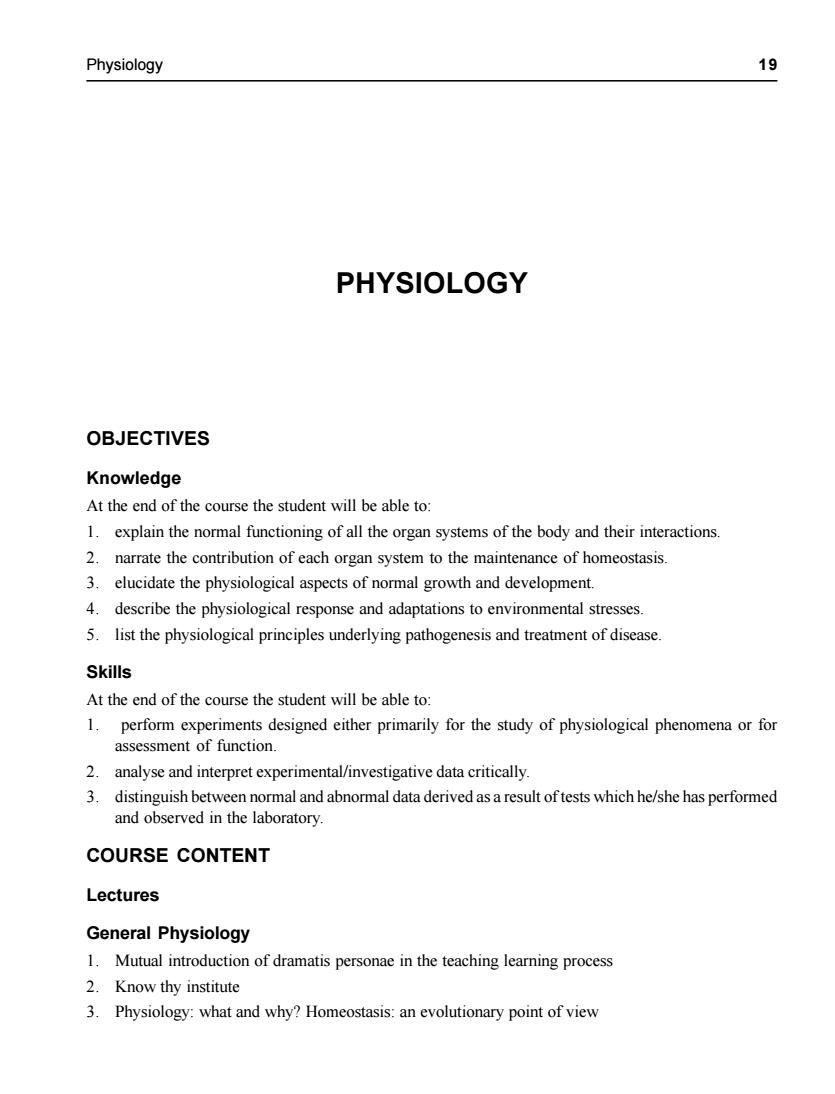
19PhysiologyPHYSIOLOGYOBJECTIVESKnowledgeAt the end of the course the student will be able to:1.explain the normal functioning of all the organ systems of the body and their interactions.2.narratethecontributionof eachorgan systemtothemaintenanceof homeostasis3.elucidatethephysiologicalaspectsofnormalgrowthanddevelopment.4.describethephysiological responseandadaptationstoenvironmental stresses.5.list the physiological principles underlying pathogenesis and treatment of disease.SkillsAt theend ofthecoursethe studentwillbeableto:1,perform experiments designed either primarily for the study of physiological phenomena or forassessment of function.2.analyse and interpret experimental/investigative data critically3.distinguish between normal and abnormal data derived as a result oftests which he/she has performedand observed in the laboratory.COURSECONTENTLecturesGeneral Physiology1.Mutual introduction of dramatis personae in the teachinglearningprocess2.Knowthyinstitute3.Physiology: what and why? Homeostasis: an evolutionary point of view
Physiology 19 PHYSIOLOGY OBJECTIVES Knowledge At the end of the course the student will be able to: 1. explain the normal functioning of all the organ systems of the body and their interactions. 2. narrate the contribution of each organ system to the maintenance of homeostasis. 3. elucidate the physiological aspects of normal growth and development. 4. describe the physiological response and adaptations to environmental stresses. 5. list the physiological principles underlying pathogenesis and treatment of disease. Skills At the end of the course the student will be able to: 1. perform experiments designed either primarily for the study of physiological phenomena or for assessment of function. 2. analyse and interpret experimental/investigative data critically. 3. distinguish between normal and abnormal data derived as a result of tests which he/she has performed and observed in the laboratory. COURSE CONTENT Lectures General Physiology 1. Mutual introduction of dramatis personae in the teaching learning process 2. Know thy institute 3. Physiology: what and why? Homeostasis: an evolutionary point of view